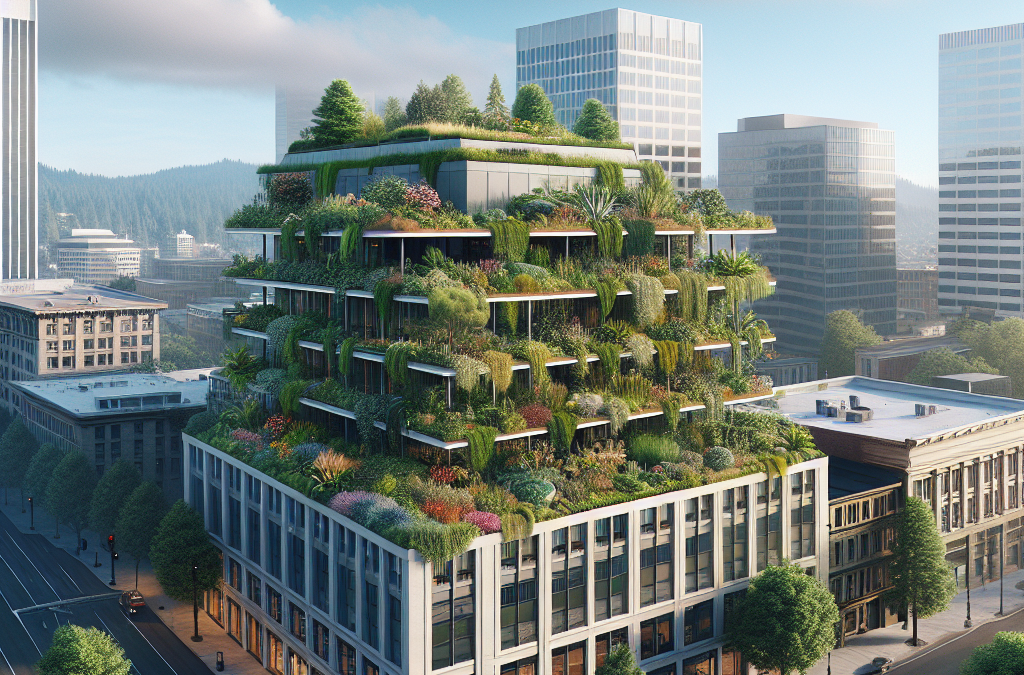Green roofs, also known as living roofs, are roofs that are partially or completely covered with vegetation and a growing medium, planted over a waterproofing membrane. They offer a myriad of benefits, both environmental and economic, that make them an increasingly popular choice for urban settings. *Portland green roof installation* is a particularly effective way to transform your space into an eco-friendly haven.
One of the primary advantages of green roofs is their ability to reduce the urban heat island effect. By absorbing heat rather than reflecting it, green roofs help to lower temperatures in urban areas, thereby reducing the need for air conditioning. Additionally, they improve air quality by filtering pollutants and carbon dioxide out of the air.
Green roofs also offer significant *economic benefits*. They can extend the lifespan of your roof by protecting it from the elements and reducing the need for frequent repairs. Furthermore, they can reduce energy costs by providing natural insulation, keeping your building warmer in the winter and cooler in the summer.
For homeowners and businesses in Portland, the aesthetic appeal of a green roof cannot be overstated. These roofs can turn an ordinary building into a visually stunning architectural feature, enhancing the overall look of your property. Moreover, they can provide additional space for gardening and recreation, making them a versatile addition to any building.
Contact us today to discover how our landscaping services can transform your property! Visit us at yardservicepdx.com to learn more.
Benefits of Installing Green Roofs

Installing a green roof comes with a wide array of benefits that can positively impact both the environment and your personal or business property. One of the most compelling *environmental benefits* is the reduction in stormwater runoff. Green roofs act as a sponge, absorbing rainwater and gradually releasing it, which helps to mitigate flooding and reduce the burden on sewer systems. This is especially relevant in cities like Portland, where heavy rainfall is common.
Another significant benefit is the enhancement of *biodiversity*. Green roofs can serve as habitats for various species of birds, insects, and other wildlife, contributing to the urban ecosystem. In areas with limited green spaces, these roofs can be crucial for supporting local flora and fauna.
From an *economic perspective*, green roofs provide excellent insulation, which can lead to substantial energy savings. By keeping buildings cooler in the summer and warmer in the winter, green roofs reduce the need for heating and air conditioning, ultimately lowering energy bills. Additionally, the protective layer of vegetation can extend the lifespan of the roofing materials underneath, reducing maintenance costs over time.
Beyond these practical advantages, green roofs also offer *aesthetic benefits*. They can transform otherwise unused rooftop spaces into beautiful, green oases that can be enjoyed by building occupants and passersby alike. This can significantly increase the property’s value and appeal. Moreover, green roofs can be designed to include walkways, seating areas, and even gardens, providing an additional recreational space for residents or employees.
In summary, the benefits of installing green roofs are multifaceted, making them a wise investment for any property owner looking to enhance sustainability, reduce costs, and improve quality of life.
Choosing the Right Green Roof System

When it comes to selecting the right green roof system for your property, several factors need to be considered to ensure the best results. The first step is to determine the *purpose* of your green roof. Are you looking to create a simple, low-maintenance green space, or do you envision a more complex setup with various plants, walkways, and seating areas? Your objectives will guide the type of system that will be most suitable.
Next, consider the *structural capacity* of your building. Green roofs add extra weight, so it’s essential to assess whether your roof can support the additional load. Consulting with a structural engineer can help you understand the limitations and possibilities of your current roof structure. This step is crucial for ensuring safety and avoiding future complications.
The *climate* in Portland is another critical factor. Given the region’s wet winters and dry summers, you’ll need a system that can handle both heavy rainfall and periods of drought. This might involve selecting plants that are native or well-adapted to the local climate, as well as incorporating an efficient irrigation system to maintain the health of your green roof year-round.
There are generally two types of green roof systems: *extensive* and *intensive*. Extensive green roofs are lightweight and feature shallow soil, making them ideal for buildings with limited structural capacity. They are typically low-maintenance and are best suited for grasses, mosses, and small plants. Intensive green roofs, on the other hand, are heavier and can support a wider variety of plants, including shrubs and small trees. These systems often require more maintenance but offer greater flexibility in design and usage.
Additionally, you’ll need to plan for *drainage and waterproofing*. Proper drainage is essential to prevent water from pooling and causing damage to your roof. Waterproofing layers and root barriers are also critical components that protect the underlying structure from water infiltration and root penetration.
By carefully considering these factors, you can choose a green roof system that not only meets your aesthetic and functional goals but also ensures long-term sustainability and performance.
The Green Roof Installation Process
Installing a green roof is a multi-step process that requires careful planning and execution to ensure long-term success. The first stage involves *preparation and planning*. This includes assessing the structural integrity of the existing roof, obtaining necessary permits, and selecting the appropriate green roof system and materials. Consulting with professionals, such as structural engineers and landscape architects, can provide valuable insights and ensure that all aspects of the project are considered.
Once the planning phase is complete, the next step is *preparing the roof*. This involves cleaning the roof surface, repairing any damage, and installing a waterproof membrane to prevent water infiltration. A root barrier is also added to protect the waterproofing layer from being penetrated by plant roots. Proper preparation is crucial for the longevity of the green roof.
Following this, *drainage layers* and *filter fabrics* are installed. The drainage layer allows excess water to flow off the roof, preventing waterlogging and ensuring that plants receive the right amount of moisture. The filter fabric prevents soil particles from clogging the drainage layer, maintaining efficient water flow.
The next phase involves adding the *growing medium*. This specially formulated soil is lighter than traditional garden soil and is designed to support plant growth while minimizing weight. The depth of the growing medium will depend on the type of green roof system chosen—extensive systems require less soil depth compared to intensive systems.
With the growing medium in place, it’s time to *plant the vegetation*. The selection of plants will depend on the climate, the type of green roof system, and the desired aesthetic and functional outcomes. For extensive green roofs, hardy, drought-resistant plants such as sedums and grasses are commonly used. Intensive green roofs offer more plant variety, including shrubs and small trees, but require more maintenance.
Finally, an *irrigation system* may be installed to ensure that plants receive adequate water, especially during dry periods. Automated irrigation systems can be highly effective, providing consistent moisture levels and reducing the need for manual watering.
Throughout the installation process, it’s important to follow best practices and guidelines to ensure a high-quality, durable green roof. Regular inspections and maintenance, particularly in the first few years, will help establish a healthy, thriving green space that enhances the building’s sustainability and aesthetic appeal.
Maintenance Tips for Green Roofs

Maintaining a green roof is crucial for its longevity and effectiveness. Proper maintenance ensures that the green roof remains healthy, aesthetically pleasing, and functional. Here are some essential *maintenance tips* to help you care for your green roof:
1. Regular Inspections: Conduct regular inspections, especially during the first few years after installation. Look for signs of plant stress, pest infestations, and any damage to the roof structure. Early detection of issues can prevent more significant problems down the line.
2. Weed Control: Weeds can compete with your chosen plants for nutrients and water. Regularly remove any unwanted vegetation to ensure that your green roof plants thrive. This is particularly important for extensive green roofs, where low-maintenance plants are used.
3. Watering: While green roofs are designed to be more drought-resistant, they still require adequate water, especially during dry periods. Check the moisture levels of the growing medium and water as needed. Automated irrigation systems can help maintain consistent moisture levels.
4. Fertilization: Nutrient levels in the growing medium can deplete over time. Periodically apply a slow-release fertilizer to replenish essential nutrients. Avoid over-fertilizing, as this can lead to nutrient runoff and negatively impact the environment.
5. Plant Replacement: Some plants may not thrive in the green roof environment and may need to be replaced. Monitor plant health and replace any struggling or dead plants to maintain a vibrant and healthy green roof.
6. Drainage Maintenance: Ensure that drainage systems are functioning correctly. Clear any debris or blockages from drainage outlets and inspect the drainage layer to prevent waterlogging and ensure proper water flow.
7. Roof Edge and Flashing Inspection: Regularly check the edges and flashing of the roof for any signs of wear or damage. Properly functioning edges and flashing are essential to prevent water infiltration and protect the structural integrity of the roof.
By following these maintenance tips, you can ensure that your green roof remains a sustainable and beautiful addition to your building. Regular care and attention will help maximize the benefits of your green roof, from improved insulation and energy efficiency to enhanced biodiversity and stormwater management.
Why Choose Portland for Green Roofs

Portland, known for its lush landscapes and eco-conscious culture, is an ideal location for green roofs. The city’s commitment to sustainability and environmental stewardship makes it a perfect place to embrace this innovative roofing solution. Here are some compelling reasons why you should choose Portland for green roof installation:
1. Ideal Climate: Portland’s temperate climate with mild, wet winters and dry summers provides an excellent environment for a variety of green roof plants. The moderate temperatures and ample rainfall support the growth and health of green roofs, reducing the need for extensive irrigation and maintenance.
2. Environmental Benefits: Green roofs in Portland can significantly reduce urban heat island effects, improve air quality, and manage stormwater runoff. With the city’s heavy rainfall, green roofs help absorb and filter rainwater, reducing the burden on stormwater systems and preventing flooding.
3. Aesthetic Appeal: Portland’s urban landscape is enhanced by the addition of green roofs. They provide a visually pleasing contrast to traditional roofing materials and offer residents and visitors a glimpse of nature amidst the urban environment. Green roofs can also create serene spaces for relaxation and recreation.
4. Community Support: The local government and community in Portland are highly supportive of green building practices. There are various incentives, grants, and resources available for green roof installations, making it more accessible and affordable for property owners to adopt this eco-friendly technology.
5. Biodiversity: Green roofs contribute to the urban ecosystem by providing habitats for birds, insects, and other wildlife. In a city like Portland, which values biodiversity and conservation, green roofs play a crucial role in supporting urban flora and fauna.
Choosing Portland for green roof installation means you are contributing to a greener, more sustainable future. The city’s supportive environment, combined with the numerous benefits of green roofs, makes it the perfect location to transform your space.
Contact us today to discover how our landscaping services can transform your property! Visit yardservicepdx.com to learn more about our green roof installation services and how we can help you create a sustainable, beautiful, and functional green roof that suits your needs.

